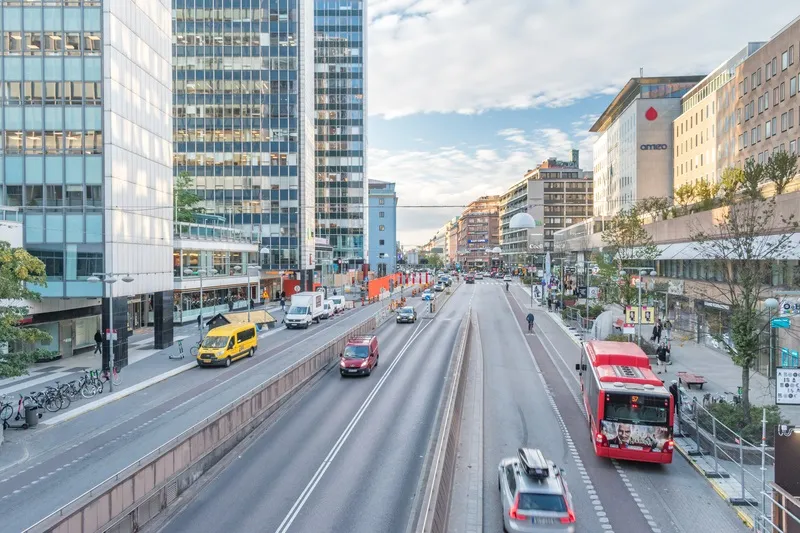
In recent advertising, Meta draws a futuristic vision of a geography-less space where people can meet without being there in person. The metaverse - according to the advertising message - will have an impact on the real world. It promises a scenario where traffic planners can do sophisticated simulations in the metaverse that will shape the way billions of people move in every corner of the world. And indeed, the metaverse has enormous potential to improve road safety, increase citizen participation and make mobility more inclusive.
In the mobility industry, original equipment manufacturers (OEM) were the first to start talking about the metaverse, virtual reality (VR) and augmented reality (AR). Already back in 2019, they presented some practical use cases such as heads-up displays and projections on windshields that enable navigation or virtual test drives of cars that can be conducted from the comfort of a prospective customer's own home.
Will the metamobility concept change transport?
At CES 2022, Hyundai Assan attracted attention with a more futuristic vision: it unveiled its “Metamobility” concept that uses a mix of technologies to enable unlimited freedom of movement. The car maker expects that mobilities, such as automobiles and urban air mobility (UAM), will serve as smart devices to access virtual spaces, while robotics will act as a medium to connect the virtual and real worlds.
Even if many of these ideas still sound like science fiction, there is no doubt that the 3D world of the metaverse will transform our lives and businesses in a profound way. Technologies such as AR and mixed reality (MR), and thus the integration of the physical and the digital world, will offer new perceptions and experiences – also when it comes to transport planning and shaping the mobility ecosystem.
Already today, urban and traffic planners use digital twins of cities and traffic networks to model, simulate and plan future mobility measures. In this digital environment all road users and their interactions as well as public transport services can be simulated and analyzed. Thus, transportation models and simulations already are essential decision-making tools to shape safer, more sustainable, and efficient mobility. The metaverse will enrich these processes. Engineers will be able to work in direct contact with full three-dimensional, life-size renderings which will open completely new possibilities and perceptions.
How do we overcome equity challenges in mobility?
People have different mobility needs. Identifying and understanding these needs is crucial to create an equal and accessible mobility system for all. How accessible is the bus stop for the elderly? What restrictions are there on the walkway for a disabled person or for a mother with a stroller? The metaverse will offer the possibility to empathise with these needs. Planners will depict different circumstances more realistically in a wide variety of scenarios and put themselves in other person’s positions. The effects of planned measures on the experience of different groups of people will enable an even more inclusive mobility design.
Paving a way to better road safety
Road safety is another area where this direct experience of a particular situation will be helpful for planning. Researchers at the Nuremberg University of Applied Sciences in Germany recently published a study on the safety of roads from the point of view of different cyclists. Subjects evaluated the safety of different road designs by experiencing different road conditions using a virtual bike simulator. Even this “basic” test environment brought up some interesting results: For example, a colored cycle lane can significantly increase the perception of safety when cycling - a lean and simple measure to promote bike traffic. Test cycles in the more sophisticated VR and AR environment of the metaverse will provide additional and even more profound results to ensure that infrastructure is optimally adapted to the needs of those who use it.
In what ways can we enable better citizen participation?
Citizen participation can be increased and enhanced through traffic simulations in the metaverse. Cities today are striving to shape livable environments and therefore shifting to a citizen-centric focus in urban and traffic planning. There is increased demand to include not only different stakeholders, but also citizens in mobility projects. Attractive visualisations, dashboards and animations already play a major role already today.
Some years back, Singapore used a VR bike simulator, to support its goal of becoming a bike friendly city and get public approval for planned infrastructure measures. In the virtual laboratory, citizens were able to test what it would be like to cycle on the proposed paths and then had a chance to vote for the best designs. This proved to be a successful way to involve people in transportation projects. And imagine how much better the experience would have been in the metaverse – to learn how it feels to bike on a new traffic-calmed road or on a green bike path instead of a fully parked street.
There is a lot of potential here to generate enthusiasm for new mobility projects. Digital development has never been as rapid and disruptive as it is today. I’m excited to see what new and established ideas will come to fruition in 2023 and beyond. One thing is certain, however, the metaverse will become an important add-on to professional mobility planning and simulation tools that will help evolve the future of smart and inclusive mobility.
ABOUT THE AUTHOR:

Christian Haas is CEO of UMovity (Econolite & PTV Mobility)










